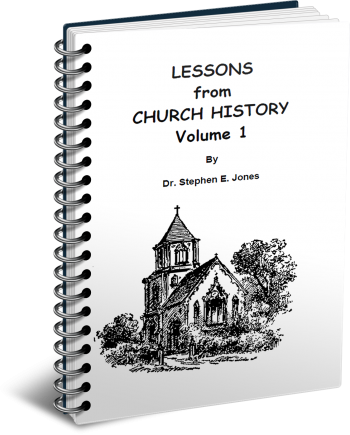Latest Posts
View the latest posts in an easy-to-read list format, with filtering options.

Volume 1. This gives a short history of the Church from the apostles to the Roman War, including Luke’s account of Paul’s journeys in the book of Acts. It includes Paul’s fourth missionary journey to Spain and Britain.
Category - History and Prophecy

The Gospel was soon preached in Egypt under the ministry of Mark, at least until Peter had need of him in his first trip to Rome, after fleeing Jerusalem in 44 A.D. (Acts 12:17).
Eusebius tells us that at some point, Peter went to Rome to preach and to confront Simon Magus for the second time (since the earlier confrontation in Samaria—Acts 8:20). He took Mark with him, though Mark was probably one of the 3,000 believers converted at Pentecost. He had never actually met Jesus personally, Eusebius says in Eccl. Hist., III, xxxix. Peter personally discipled Mark for the rest of his life.
Peter, it seems visited Rome at least twice, the first time in about 44 or 45 A.D. after fleeing from Jerusalem, and the second time 20 years later when he was martyred with Paul. In his second missionary trip to Rome, just before he was martyred, he instructed Mark to write his Gospel as a summary, so that the people in Rome would have something in writing from his perspective. Some scholars, assuming that the simplest gospel must of necessity be the first, say that Mark is the earliest Gospel, but actually Matthew’s first edition had already been written and was, for many years, the only gospel writing available to the people. Eusebius says,
“Now Irenaeus was one of these [people quoting from the authentic canon of the gospels], so let us quote his words . . . as follows: ‘Now Matthew published among the Hebrews a written gospel also in their own tongue, while Peter and Paul were preaching in Rome and founding the church. But after their death Mark also, the disciple and interpreter of Peter, himself handed down to us in writing the things which were preached by Peter, and Luke also, who was a follower of Paul, put down in a book the gospel which was preached by him. Then John, the disciple of the Lord, who had even rested on his breast, himself also gave forth the gospel, while he was living at Ephesus in Asia’.”
Eusebius says that Matthew’s gospel came first and was first published in Hebrew. He says that Mark’s gospel was written after Peter’s final visit to Rome (after 66 A.D.), and that Luke’s gospel was written shortly afterward. Then later came John’s gospel.
It is significant that Mark tells the story of Peter's denial of Christ (Mark 14:68-72). Written under Peter's instructions, it shows that Peter was not interested in hiding his past sin, but in teaching others the right way by his own negative example.
“It is also recorded that under Claudius, Philo came to Rome to have conversations with Peter,” says Eusebius (Eccl. Hist., II, xvii). Philo was a very important Jewish philosopher of the day. He lived from about 20 B.C. to about 50 A.D., so Peter must have preached in Rome in the mid-40's A.D. after fleeing Jerusalem (Acts 12) and then returned 20 years later for martyrdom.
Some time after Mark and Peter returned from their first trip to Rome, Mark went to Alexandria, Egypt, and became its bishop, for he was replaced as bishop by Annianus in the eighth year of Nero (i.e., 61 or 62 A.D.) [Eccl. Hist., II, xxiv]. It is likely, then, that Mark had originally been a resident of Alexandria, and that he had come to Jerusalem for Pentecost in 33 A.D. and was converted with the 3,000 on that day.
Eusebius also tells us where other disciples went:
“Meanwhile, the holy apostles and disciples of our Saviour were scattered over the whole world. Thomas, tradition tells us, was chosen for Parthia. Andrew for Scythia, John for Asia, where he remained till his death at Ephesus.” [Eccl. Hist., III, i]
Edessa, a prominent city in Syria, may have been converted wholesale when its King Abgar V was healed and converted to Christ through the ministry of Thaddeus. Eusebius tells us in Eccl. Hist. I, xiii, that Abgar had written to Jesus earlier and asked him to come and heal him, telling him that He would be well protected in his city. But Jesus wrote back and told him that He could not come, but would later send a disciple. Thus, Thaddeus was sent some time after the day of Pentecost, and the whole city was converted. (See the full text of the letters in Appendix 3.)
Many dispute the authenticity of Abgar’s letter to Jesus, claiming that the first King of Edessa to embrace Christianity was Abgar IX in 206 A.D. However, in view of the rapid spread of the gospel from Britain to India in such a short time, it is unlikely that Edessa would have little or no witness until the third century. It is quite possible, though, that between the fifth and the ninth Abgars there was a falling away from the faith, and that Abgar IX simply re-instated Christianity as the official religion of Edessa.
It is further claimed that Addai was the first bishop of Edessa. He was a missionary from Palestine in the middle of the second century. Yet Eusebius was closer in both time and distance than we are today and may have had original documents that we do not possess today. He was, after all, the curator of the large Christian library in Caesarea known as the library of Pamphilius. It was a branch library of the main one located on the Mount of Olives on the east side of Jerusalem. Eusebius makes references to this library in Eccl. Hist. VI, xx, i, saying,
“Now there flourished at that time many learned churchmen, and the letters which they penned to one another are still extant and easily accessible. They have been preserved even to our day in the library at Aelia [the Roman name for Jerusalem], equipped by Alexander, then ruling the church there; from which also we have been able ourselves to gather together the material for our present work.”
In his day, Edessa had a well-established Church, having records of their own. Eusebius had surely seen this correspondence from the Church in Edessa in the church library in Aelia.
At any rate, the Church in Edessa was a major Christian center and produced the Peshitta (that is, the Syriac Bible in the Aramaic language). The Shroud of Turin was first found in Edessa in 544 A.D. above a gate in the city’s walls. This Shroud is a burial cloth with a faint, full-body image of Jesus, complete with bloodstains. It was carried to the West in 1204 during the Fourth Crusade when the French and Venetian knights looted the city.
Eusebius also mentions “Timothy, stated to have been the first bishop appointed to the see of Ephesus, as was Titus to the churches of Crete.” [Eccl. Hist., III, iv]
In Eccl. Hist. III, iv we also read:
“Luke, by birth an Antiochene and by profession a physician, was for long periods a companion of Paul and was closely associate with the other apostles as well. . . It is actually suggested that Paul was in the habit of referring to Luke's gospel whenever he said, as if writing of some Gospel of his own: ‘According to my gospel’.” [Note: Rom.2:16,16:25; and 2 Tim. 2:8]
Yet the gospel accounts were still being written, particularly Paul’s gospel, whether this was the gospel of Luke, the book of Hebrews, or even the book of Acts. No one knows for sure what Paul meant by his statement, but it is certain that none of these were completed until just before or after his martyrdom in Rome.
Meanwhile, a man named Evodius was the first bishop in Antioch. One of the young men in that Church was Ignatius, reputed to be one of the children Jesus blessed as an illustration of how to enter the Kingdom (Mark 10:16). Ignatius was about three years old at the time, but even at that young age, he was one of the 500 witnesses (1 Cor. 15:6) who saw Jesus after His resurrection. He later became the famous and influential bishop of Antioch, and finally died in an unshakable faith as a martyr in 107 A.D. during the reign of Trajan.
Paul, of course, of whom we have said little up to this point, began his ministry in 47 after he and Barnabas returned from their trip to Jerusalem to bring financial aid to the believers there (Acts 11:30). This took place in conjunction with the famine that took place in the days of Claudius (47 A.D.) It was also the 14th year since Paul's conversion in 33 A.D. (Gal. 2:1).
Paul ministered in Asia (modern Turkey) until he was taken prisoner to Rome after the Day of Atonement in 60 A.D. Because the ship was wrecked, however, he did not arrive in Rome until the Spring of 61. He remained in Rome two years before Nero acquitted him through the influence of his tutor, Seneca, the Roman lawyer, who was also Paul's friend and fellow philosopher. Paul then went to Spain and to Britain to preach the Word. When he returned in 66 A.D., both he and Peter were condemned to death together under Nero, for by this time Seneca had fallen out of favor with Nero, and the great fire of Rome in July of 64 had been blamed on the Christians.
As a Roman citizen, Paul was beheaded. Peter, who did not enjoy Roman citizenship, was crucified upside down—at his own request, not feeling worthy to suffer in the same way as Jesus had before him. Both Paul and Peter were originally buried in Rome, but later, in 656 A.D., according to Bede, a devout Roman Catholic historian, Pope Vitalian sent their remains to Britain upon request from England's King Oswy. [Bedoe hist. lib. iii, c. 29] Bede lived just a century later, so this historical fact was to him recent history.
King Oswy had been instrumental in bringing England's Church into submission to Rome, and they were rewarded with the bodies of St. Peter, St. Paul, St. John, St. Lawrence, St. Gregory, and St. Pancras. [St. Paul in Britain, Rev. W. Morgan, footnote, p. 125]
Yet even before the martyrdom of Peter and Paul, Peter's wife was put to death on account of her witness. Eusebius quotes Clement's Miscellanies, Book VII, saying,
“We are told that when blessed Peter saw his wife led away to death, he was glad that her call had come and that she was returning home, and spoke to her in the most encouraging and comforting tones, addressing her by name: ‘My dear, remember the Lord.’ Such was the marriage of the blessed, and their consummate feeling towards their dearest.” [Eccl. Hist. III, xxx]
In those days, men and women alike were equally among the martyrs for the witness of Christ. Rome apparently recognized that in Christ there was neither male nor female, for they treated them equally in this respect. Peter's wife's mother is mentioned in Mark 1:30, 31 when Jesus healed her of a fever.
This is but a partial list of the characters, and yet they help us to bring the early Church to life. This is not mere history, but a record of real people who lived, who loved, and who died in Christ. It would be a tragedy if their stories were lost, for their memories should live on in us to inspire future generations.